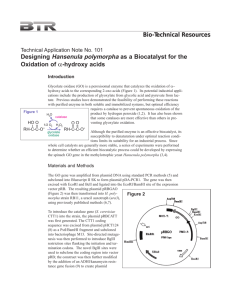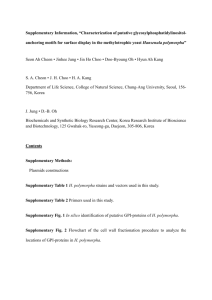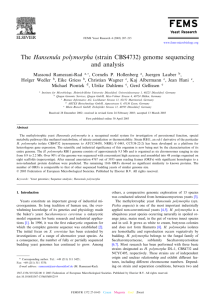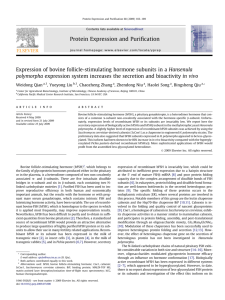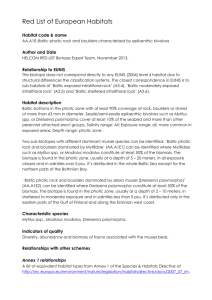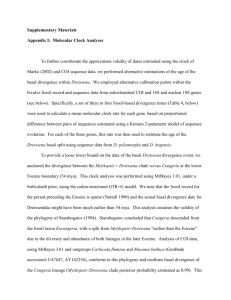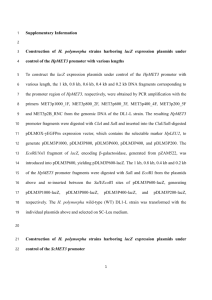The 2nd Hansenula polymorpha worldwide network conference
advertisement
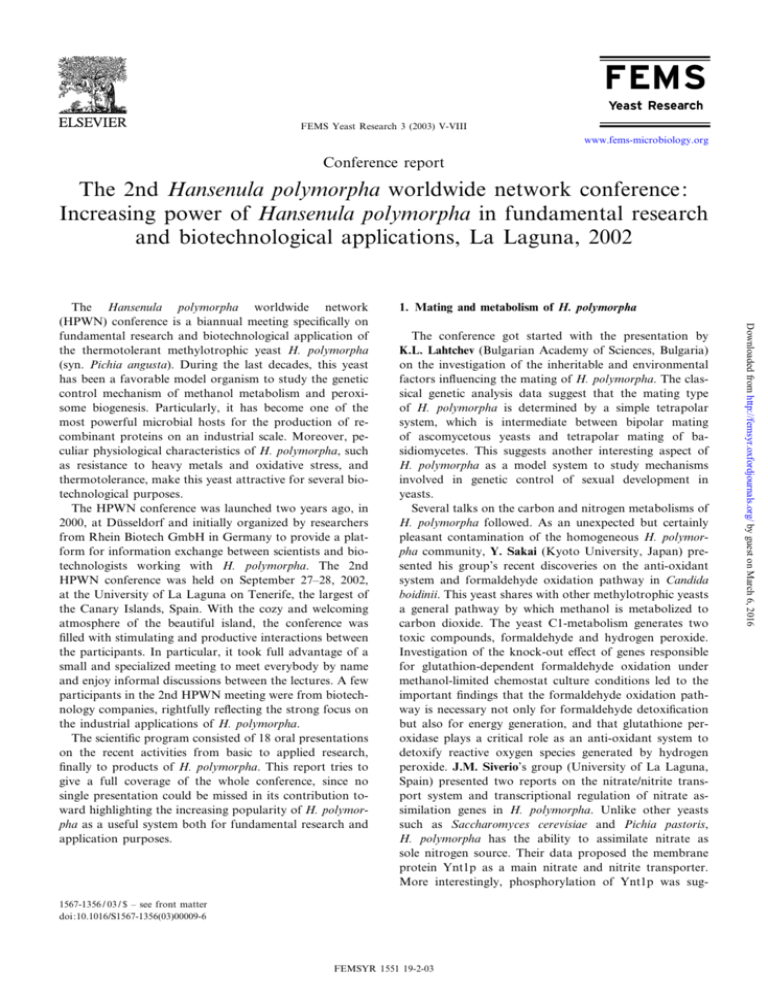
FEMS Yeast Research 3 (2003) V-VIII www.fems-microbiology.org Conference report The 2nd Hansenula polymorpha worldwide network conference: Increasing power of Hansenula polymorpha in fundamental research and biotechnological applications, La Laguna, 2002 1. Mating and metabolism of H. polymorpha The conference got started with the presentation by K.L. Lahtchev (Bulgarian Academy of Sciences, Bulgaria) on the investigation of the inheritable and environmental factors in£uencing the mating of H. polymorpha. The classical genetic analysis data suggest that the mating type of H. polymorpha is determined by a simple tetrapolar system, which is intermediate between bipolar mating of ascomycetous yeasts and tetrapolar mating of basidiomycetes. This suggests another interesting aspect of H. polymorpha as a model system to study mechanisms involved in genetic control of sexual development in yeasts. Several talks on the carbon and nitrogen metabolisms of H. polymorpha followed. As an unexpected but certainly pleasant contamination of the homogeneous H. polymorpha community, Y. Sakai (Kyoto University, Japan) presented his group’s recent discoveries on the anti-oxidant system and formaldehyde oxidation pathway in Candida boidinii. This yeast shares with other methylotrophic yeasts a general pathway by which methanol is metabolized to carbon dioxide. The yeast C1-metabolism generates two toxic compounds, formaldehyde and hydrogen peroxide. Investigation of the knock-out e¡ect of genes responsible for glutathion-dependent formaldehyde oxidation under methanol-limited chemostat culture conditions led to the important ¢ndings that the formaldehyde oxidation pathway is necessary not only for formaldehyde detoxi¢cation but also for energy generation, and that glutathione peroxidase plays a critical role as an anti-oxidant system to detoxify reactive oxygen species generated by hydrogen peroxide. J.M. Siverio’s group (University of La Laguna, Spain) presented two reports on the nitrate/nitrite transport system and transcriptional regulation of nitrate assimilation genes in H. polymorpha. Unlike other yeasts such as Saccharomyces cerevisiae and Pichia pastoris, H. polymorpha has the ability to assimilate nitrate as sole nitrogen source. Their data proposed the membrane protein Ynt1p as a main nitrate and nitrite transporter. More interestingly, phosphorylation of Ynt1p was sug- 1567-1356 / 03 / $ ^ see front matter doi:10.1016/S1567-1356(03)00009-6 FEMSYR 1551 19-2-03 Downloaded from http://femsyr.oxfordjournals.org/ by guest on March 6, 2016 The Hansenula polymorpha worldwide network (HPWN) conference is a biannual meeting speci¢cally on fundamental research and biotechnological application of the thermotolerant methylotrophic yeast H. polymorpha (syn. Pichia angusta). During the last decades, this yeast has been a favorable model organism to study the genetic control mechanism of methanol metabolism and peroxisome biogenesis. Particularly, it has become one of the most powerful microbial hosts for the production of recombinant proteins on an industrial scale. Moreover, peculiar physiological characteristics of H. polymorpha, such as resistance to heavy metals and oxidative stress, and thermotolerance, make this yeast attractive for several biotechnological purposes. The HPWN conference was launched two years ago, in 2000, at Du«sseldorf and initially organized by researchers from Rhein Biotech GmbH in Germany to provide a platform for information exchange between scientists and biotechnologists working with H. polymorpha. The 2nd HPWN conference was held on September 27^28, 2002, at the University of La Laguna on Tenerife, the largest of the Canary Islands, Spain. With the cozy and welcoming atmosphere of the beautiful island, the conference was ¢lled with stimulating and productive interactions between the participants. In particular, it took full advantage of a small and specialized meeting to meet everybody by name and enjoy informal discussions between the lectures. A few participants in the 2nd HPWN meeting were from biotechnology companies, rightfully re£ecting the strong focus on the industrial applications of H. polymorpha. The scienti¢c program consisted of 18 oral presentations on the recent activities from basic to applied research, ¢nally to products of H. polymorpha. This report tries to give a full coverage of the whole conference, since no single presentation could be missed in its contribution toward highlighting the increasing popularity of H. polymorpha as a useful system both for fundamental research and application purposes. VI FEMS Yeast Research 3 (2003) V-VIII gested as a key mechanism of post-translational regulation of the nitrate assimilation pathway. In a search for new transcriptional factors involved in the nitrate assimilation, a novel protein with a DNA-binding domain of GATA factors, designated as HpGat1p, was isolated and shown to be involved in the induction of nitrate assimilation genes in H. polymorpha. 2. Peroxisome biogenesis of H. polymorpha 3. Protein secretion and processing in H. polymorpha As a eukaryotic microbial expression system, yeast is certainly advantageous over prokaryotic systems for the production of secretory recombinant proteins. However, 4. Platform technologies for biotechnological applications Several presentations were about the development of new H. polymorpha-based platform technologies for industrial applications. Using plasmids harboring a portion of the H. polymorpha ribosomal DNA, M. Suckow (Rhein Biotech GmbH, Germany) was able to achieve singlestep co-integration of multiple heterologous gene expression cassettes into the host chromosomal DNA. Whereas the conventional approach using HARS plasmids requires di¡erent selection markers in combination with host strains carrying corresponding de¢ciencies, the rDNA integration approach was able to facilitate co-integration of three di¡erent plasmids containing the same selection marker in a host strain carrying only a single auxotrophic marker. This approach is expected to provide a new and attractive tool for the rapid generation of recombinant strains that simultaneously co-produce several proteins in desired stoichiometric ratios. The same concept of co-integration into the ribosomal DNA was also tested for its application to another yeast of biotechnological interest. J. Klabunde from C.P. Hollenberg’s group (HeinrichHeine University, Germany) reported on their feasibility study to use the H. polymorpha rDNA cassettes to transform Arxula adeninivorans, which has some unusual bio- FEMSYR 1551 19-2-03 Downloaded from http://femsyr.oxfordjournals.org/ by guest on March 6, 2016 One of the special values of methylotrophic yeasts in fundamental research is undoubtedly related to studies on biogenesis and degradation of peroxisomes, since the morphological features of peroxisome development and selective degradation are more strongly pronounced in these yeast species than in the traditional yeast S. cerevisiae. One of the current hot issues in this ¢eld is to elucidate interrelationships between biogenesis and degradation of peroxisomes. As a result of their recent e¡orts to isolate suppressors of pex mutations, O.V. Stasyk from A.A. Sibirny’s group (Institute of Cell Biology, Ukraine) obtained important data implying that Pex1p and Pex6p would be genetic elements mutual to both processes. J. Kiel from M. Veenhuis’ group (University of Groningen, The Netherlands) gave an intriguing talk on sorting and assembly of peroxisomal methanol oxidase (MOX), which is a homo-octameric £avoprotein. They found that MOX without the peroxisomal targeting signal 1 (PTS1) sequence was still normally imported into peroxisomes in the receptor protein Pex5p-dependent way. This indicates the presence of a second targeting sequence besides PTS1. More surprisingly, their current data suggested that pyruvate carboxylase might facilitate FAD-binding to MOX monomers in the cytosol, which appeared to be essential for e⁄cient interaction with Pex5p and subsequent import into peroxisomes. E. Berardi (University of Ancona, Italy) introduced his group’s research activities on isolating and characterizing novel genes involved in the expression of MOX and presented MUT3 and MUT10 as essential genes for peroxisome proliferation. Whereas MUT3 was identi¢ed as a gene coding for a transcriptional activator of the Zn2 Cy6 family, MUT10 was found to encode a ClC chloride channel involved in Fe homeostasis and in respiration. This unexpected ¢nding implies that methanol metabolism and peroxisome biogenesis are somehow dependent on a physiological role of Mut10p, which is associated with chloride channel activity. some of the secretory proteins of higher eukaryotes are not properly secreted and processed even in yeasts. Development of H. polymorpha expression systems for improved secretion capacity and for proper glycosylation processing requires detailed insight into cellular and molecular control mechanisms of protein secretion and processing in H. polymorpha. H.A. Kang from S.K. Rhee’s group (Korea Research Institute of Bioscience and Biotechnology, Korea) presented their recent work to elucidate the protein glycosylation pathway in H. polymorpha through studies on N-linked glycosylation mutant strains with defects in outer-chain formation. It is noteworthy that the outerchain processing of N-glycans by H. polymorpha appears to be quite di¡erent from that by S. cerevisiae, in that H. polymorpha N-glycans were shown to have generally shorter outer mannose chains and no highly antigenic terminal K-1,3-linked mannose. From elaborate work to search for a set of mutants with increased secretion ability, M.O. Agaphonov (Cardiology Research Center, Russia) was able to isolate several novel genes responsible for supersecretion phenotype. One of them was identi¢ed as a H. polymorpha homolog to S. cerevisiae KCOP, a component of the COPI complex, which is known to be involved in retrograde vesicular transport from the Golgi to the ER. However, in contrast to S. cerevisiae, the C-terminal truncation of KCOP was not lethal for H. polymorpha. These reports indicate that organization of protein secretion and processing machinery in yeasts are signi¢cantly species-speci¢c. FEMS Yeast Research 3 (2003) V-VIII 5. Development of industrial processes During the last decades, H. polymorpha has increasingly drawn the attention of biotechnologists to explore advantages of this yeast in developing versatile industrial processes, particularly for the production of recombinant proteins. Several contributors to the conference presented their work on the product and strain developments in the H. polymorpha system. C. Sto«ckmann (Aachen University of Technology, Germany) reported their collaborative work with Rhein Biotech GmbH on the development of recombinant strains producing phytase. Based on their experience with the substantial e¡ect of oxygen supply in the screening of the recombinant strains, they recommended the passaging and screening under oxygen limitation as bene¢cial conditions for assessing phytase production and for identifying suitable production strain candidates. E. de Bruin (Agrotechnological Research Institute, The Netherlands) summarized the current developments on the production of recombinant human collagen using methylotrophic yeasts as host strains. In contrast to P. pastoris, H. polymorpha was able to produce endogenous collagen-like proteins with 4-hydroxyproline amino acid residues, although the hydroxylation e⁄ciency was not high enough to generate thermally stable collagen trimers. Several putative genes coding for prolyl 4-hydroxylase were recently isolated from various eukaryotic microbial systems, including H. polymorpha. These genes are expected to be useful to develop yeasts into cell factories for the production of stable human collagens. F. Mu«ller (Rhein Biotech GmbH, Germany) described the overall schematic of the development of the INFK-2a production system in H. polymorpha from upstream to downstream. Improvement of correct processing of the MFK1 signal sequence fused to IFNK-2a was achieved by co-expression of the S. cerevisiae-derived KEX2 gene from its native promoter. A pO2 -controlled C-source feeding mode was developed for large-scale fermentations, yielding up to 250 mg l31 of the recombinant IFNK-2a, which was puri¢ed to homogeneity just by two-step chromatographic procedures. A detailed clinical overview on HepavaxGene, the most well-known H. polymorpha-produced recombinant pharmaceutical, was presented by K.-O. Kim (Green Cross Vaccine Corp., Korea). At present, Hepavax-Gene is the third largest hepatitis B vaccine supplied into the worldwide market and numerous studies on the safety and immunogenicity of Hepavax-Gene have proven that the H. polymorpha-derived recombinant vaccine has an excellent safety and e⁄cacy pro¢le. 6. H. polymorpha genome sequencing and analysis The most exciting moment in the conference was de¢nitely the announcement of the completion of the H. polymorpha genome sequencing, which was ¢nancially supported by Rhein Biotech GmbH. As co-contributors, M.R. Rad from Heinrich-Heine University, E. Griess from Qiagen GmbH, and J. Hani from Biomax Informatics AG in Germany reported on the current status of the H. polymorpha genome sequencing and analysis. The size of the H. polymorpha genome was estimated to be about 9.5 Mb, which is about 3 Mb smaller than that of the S. cerevisiae genome. By shotgun sequencing of BAC libraries, the H. polymorpha genome was at present assembled to 48 contigs and joined to 8 supercontigs with a unique size of 8.73 Mb. An automatic assignment of the genome sequence revealed about 5500 ORFs with similarity to a non-redundant protein database. With the completion of the H. polymorpha genome sequencing, various functional-genomics technologies including transciptome, proteome, and metabolome analyses are expected to be feasible with H. polymorpha in the near future. This will enhance our understanding of cellular physiology at the global level and thus accelerate strain and process improvement in H. polymorpha-based bioprocesses. It is evident that non-S. cerevisiae yeasts are playing increasingly important roles both in fundamental research and in the industrial applications. The 2nd HPWN conference corroborated the power of H. polymorpha not only as a model system but also as a cell factory. The next conference is scheduled for 2004 in Italy and a web page for H. polymorpha Worldwide Network is currently in preparation. On behalf of all the participants of the 2nd HPWN conference, I thank the organizing committee, G. Gellissen (Rhein Biotech GmbH) and J.M. Siverio (University of La FEMSYR 1551 19-2-03 Downloaded from http://femsyr.oxfordjournals.org/ by guest on March 6, 2016 chemical and physiological characteristics, such as thermoresistance, halotolerance, and temperature-dependent dimorphism. While characterizing the H. polymorpha maltase gene (HPMAL1), T. Alama«e (University of Tartu, Estonia) noticed that the HPMAL1 promoter was as strong as the most currently used MOX promoter in directing expression of several heterologous genes. Moreover, the HPMAL1 promoter was also functional both in Escherichia coli and S. cerevisiae, presenting its potential as a convenient element in making a wide host range expression plasmid. As a novel biotechnological application of H. polymorpha to the production of renewable and cheap ethanol, A.A. Sibirny (Institute of Cell Biology, Ukraine) introduced his group’s current e¡orts to obtain acetaldehyde or ethanol as the ¢nal product of fermentation. They were able to obtain acetaldehyde from glucose fermentation by a mixed yeast culture consisting of an S. cerevisiae mutant defective in respiration and an H. polymorpha mutant defective in glucose catabolite repression. Furthermore, it was shown that H. polymorpha fermented glucose and xylose to ethanol both at 30‡C and 37‡C, whereas the wellknown xylose-fermenting yeast Pichia stipitis could not e¡ectively ferment both sugars at 37‡C. VII VIII FEMS Yeast Research 3 (2003) V-VIII Laguna), for their marvelous job in arranging stimulating scienti¢c programs along with exciting social events, including a fantastic dinner party and a guided tour of Teide. I specially thank Rhein Biotech GmbH, Du«sseldorf, for ¢nancial support for this conference. Hyun Ah Kang Metabolic Engineering Laboratory, Korea Research Institute of Bioscience and Biotechnology, Daejon, South Korea December 2002 Downloaded from http://femsyr.oxfordjournals.org/ by guest on March 6, 2016 FEMSYR 1551 19-2-03
